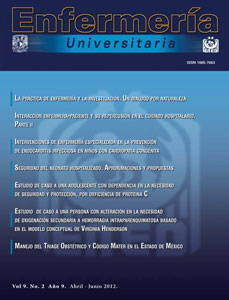Obstetric triage and management mater code in the State of Mexico
Main Article Content
Abstract
Despite the various initiatives for a solution which have been promoted in recent years, the death of women during pregnancy, childbirth and postpartum remains an unsolved problem. Although, the number of maternal deaths has been decreasing since the year 2000, this rate is still far from the target of the Millennium Goals. According to the WHO, the three major causes of maternal mortality are: hypertensive disorders of pregnancy, severe bleeding during the obstetric event, and sepsis.
The ISEM, aware of the great responsibility which this population demands, implemented a series of strategies and protocols in order to provide pregnant women with timely attention, detect risk factors, determine early diagnoses, and offer appropriate treatments to further contribute to reduce the maternal mortality; the protocols are: The Obstetric Triage and The Mater Code.
Objective: To disseminate the established protocols and strategies those have enabled faster care in pregnant women and reduce maternal mortality in General Hospital Ecatepec The Americas in the State of Mexico.
Conclusions: The evidence suggests that the protocols and strategies implemented significantly contributed to reduce the Hospital’s maternal deaths. This outcome can also be attributed to the continued training of the multidisciplinary health team in the response of obstetric emergencies.
Publication Facts
Reviewer profiles N/A
Author statements
- Academic society
- N/A
- Publisher
- Universidad Nacional Autónoma de México
Article Details
Dimensions citation
MÉTRICAS

This work is licensed under a Creative Commons Attribution-NonCommercial-NoDerivatives 4.0 International License.
Enfermería Universitaria by Universidad Nacional Autónoma de México it is distributed under the License Creative Commons Attribution - NonCommercial - NoDerivatives 4.0 International
Accepted and published articles become open-access under the terms of the Creative Commons CC BY-NC-ND 4.0 license, which authorizes the reproduction and sharing without commercial purposes, provided the corresponding acknowledgments to their authors. Authors are allowed to manage a self-archive copy of the article’s published version so that they can open-access it in their personal or institutional web pages, and/or any other broad-diffusion space.


